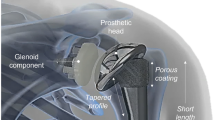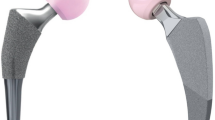Abstract
Finite element (FE) modelling can provide detailed information on implant stability; however, its computational cost limits the possibility of completing large numerical analyses into the effect of surgical variability in a cohort of patients. The aim of this study was to develop an efficient surrogate model for a cohort of patients implanted using a common cementless hip stem. FE models of implanted femora were generated from computed tomography images for 20 femora (11 males, 9 females; 50–80 years; 52–116 kg). An automated pipeline generated FE models for 61 different unique scenarios that span the femur-specific range of implant positions. Peak hip contact and muscle forces for stair climbing were scaled to the donors’ body weight and applied to the models. A cohort-specific surrogate for implant micromotion was constructed from Gaussian process models trained using data from FE simulations representing the median and extreme implant positions for each femur. A convergence study confirmed suitability of the sampling method for cohorts with 10+ femora. The final model was trained using data from the 20 femora. Results showed very good agreement between the FE and the surrogate predictions for a total of 1036 alignment scenarios [root mean squared error (RMSE) < 20 µm; \(R_{\text{validation}}^{2}\) = 0.81]. The total time required for the surrogate model to predict the micromotion range associated with surgical variability was approximately one-eighth of the corresponding full FE analysis. This confirms that the developed model is an accurate yet computationally cheaper alternative to full FE analysis when studying the implant robustness in a cohort of 10+ femora.






Similar content being viewed by others
References
Al-Dirini RMA et al (2017) Influence of collars on the primary stability of cementless femoral stems: a finite element study using a diverse patient cohort. J Orthop Res 36(4):1185–1195
Al-Dirini RM et al (2018a) Evaluating the primary stability of standard vs lateralised cementless femoral stems: a finite element study using a diverse patient cohort. Clin Biomech 59:101–109
Al-Dirini RM et al (2018b) Biomechanical robustness of a contemporary cementless stem to surgical variation in stem size and position. J Biomech Eng 140(9):091007
Al-Dirini RM et al (2019) Virtual trial to evaluate the robustness of cementless femoral stems to patient and surgical variation. J Biomech 82:346–356
Amirouche F, Solitro G, Walia A (2016) No effect of femoral offset on bone implant micromotion in an experimental model. Orthop Traumatol Surg Res 102(3):379–385
Amis AA, Jones MM (1988) The interior of the flexor tendon sheath of the finger. The functional significance of its structure. J Bone Joint Surg Br 70(4):583–587
Australian Orthopaedic Association National Joint Replacement Registry (2015) Hip and knee arthroplasty annual report 2015. Australian National Joint Arthroplasty Register, Adelaide
Bah MT et al (2011) Efficient computational method for assessing the effects of implant positioning in cementless total hip replacements. J Biomech 44:1417–1422
Bieger R et al (2013) Biomechanics of a short stem: in vitro primary stability and stress shielding of a conservative cementless hip stem. J Orthop Res 31(8):1180–1186
Camine VM et al (2018) Effect of a collar on subsidence and local micromotion of cementless femoral stems: in vitro comparative study based on micro-computerised tomography. Int Orthop 42(1):49–57
Clement JG (2005) The Melbourne Femur Collection: the gift of tissue underpins important medical and forensic research. VIFM Rev 3:7–11
Dammak M et al (1997) Friction properties at the bone-metal interface: comparison of four different porous metal surfaces. J Biomed Mater Res Off J Soc Biomater Jpn Soc Biomater 35(3):329–336
Dopico-González C, New AM, Browne M (2010) Probabilistic finite element analysis of the uncemented hip replacement-effect of femur characteristics and implant design geometry. J Biomech 43(3):512–520
Eskelinen A et al (2005) Total hip arthroplasty for primary osteoarthrosis in younger patients in the Finnish arthroplasty register: 4 661 primary replacements followed for 0–22 years. Acta Orthop 76(1):28–41
Fitzpatrick CK, Hemelaar P, Taylor M (2014) Computationally efficient prediction of bone-implant interface micromotion of a cementless tibial tray during gait. J Biomech 47(7):1718–1726
Hailer NP, Garellick G, Kärrholm J (2010) Uncemented and cemented primary total hip arthroplasty in the Swedish Hip Arthroplasty Register: evaluation of 170,413 operations. Acta Orthop 81(1):34–41
Hashemi A, Shirazi-Adl A, Dammak M (1996) Bidirectional friction study of cancellous bone-porous coated metal interface. J Biomed Mater Res 33(4):257–267
Havelin LI et al (1995) Early aseptic loosening of uncemented femoral components in primary total hip replacement. A review based on the Norwegian Arthroplasty Register. Bone Joint J 77(1):11–17
Heller MO et al (2001) Influence of femoral anteversion on proximal femoral loading: measurement and simulation in four patients. Clin Biomech 16(8):644–649
Heller MO et al (2005) Determination of muscle loading at the hip joint for use in pre-clinical testing. J Biomech 38(5):1155–1163
Keaveny TM, Bartel DL (1993) Effects of porous coating, with and without collar support, on early relative motion for a cementless hip prosthesis. J Biomech 26(12):1355–1368
Kurtz S et al (2007a) Projections of primary and revision hip and knee arthroplasty in the United States from 2005 to 2030. J Bone Joint Surg Am 89(4):780–785
Kurtz SM et al (2007b) Future clinical and economic impact of revision total hip and knee arthroplasty. J Bone Joint Surg Am 89(Suppl 3):144–151
Learmonth ID, Young C, Rorabeck C (2007) The operation of the century: total hip replacement. Lancet 370(9597):1508–1519
Maloney WJ et al (1989) Biomechanical and histologic investigation of cemented total hip arthroplasties. A study of autopsy-retrieved femurs after in vivo cycling. Clin Orthop Relat Res 249:129–140
Manu (2019) nonrigidICP, MATLAB Central File Exchange
Martelli S et al (2011a) Extensive risk analysis of mechanical failure for an epiphyseal hip prothesis: a combined numerical-experimental approach. Proc Inst Mech Eng 225(2):126–140
Martelli S et al (2011b) A new hip epiphyseal prosthesis: design revision driven by a validated numerical procedure. Med Eng Phys 33(10):1203–1211
Morgan EF, Bayraktar HH, Keaveny TM (2003) Trabecular bone modulus-density relationships depend on anatomic site. J Biomech 36(7):897–904
Myers CA et al (2018) The impact of hip implant alignment on muscle and joint loading during dynamic activities. Clin Biomech 53:93–100
O’Hagan A, Kennedy MC, Oakley JE (1999) Uncertainty analysis and other inference tools for complex computer codes (with discussion). In: Bernardo JM et al (eds) Bayesian statistics, vol 6. Oxford University Press, pp 503–524
O’Rourke D et al (2016) A computational efficient method to assess the sensitivity of finite-element models: an illustration with the hemipelvis. J Biomech Eng 138(12):121008
Pilliar RM, Lee JM, Maniatopoulos C (1986) Observations on the effect of movement on bone ingrowth into porous-surfaced implants. Clin Orthop Relat Res 208:108–113
Søballe K et al (1992) Tissue ingrowth into titanium and hydroxyapatite-coated implants during stable and unstable mechanical conditions. J Orthop Res 10(2):285–299
Solitro GF et al (2016) Measures of micromotion in cementless femoral stems-review of current methodologies. Biomater Biomech Bioeng 3(2):85–104
Taddei F et al (2010) Finite element modeling of resurfacing hip prosthesis: estimation of accuracy through experimental validation. J Biomech Eng 132(2):021002
Taylor M, Bryan R, Galloway F (2013) Accounting for patient variability in finite element analysis of the intact and implanted hip and knee: a review. Int J Numer Methods Biomed Eng 29(2):273–292
Troelsen A et al (2013) A review of current fixation use and registry outcomes in total hip arthroplasty: the uncemented paradox. Clin Orthop Relat Res 471(7):2052–2059
Viceconti M et al (2000) Large-sliding contact elements accurately predict levels of bone-implant micromotion relevant to osseointegration. J Biomech 33(12):1611–1618
Wechter J et al (2013) Improved survival of uncemented versus cemented femoral stems in patients aged < 70 years in a community total joint registry. Clin Orthop Relat Res 471(11):3588–3595
Acknowledgements
The authors are grateful to the staff of the Mortuary and the Donor Tissue Bank at the Victorian Institute of Forensic Medicine Australia for their assistance in collecting the material upon which this study is based. The authors are also grateful to the families of the donors who gave permission or the collection of the material expressly for research. The Australian Research Council (DP180103146, FT180100338) is also gratefully acknowledged.
Funding
This study was part of a project funded by the Australian Research Council (DP180103146, FT180100338), with partial funding from DePuy Synthes.
Author information
Authors and Affiliations
Corresponding author
Ethics declarations
Conflict of interest
Prof. Taylor and Dr. Martelli are chief investigators named on the ARC Grants. Dr. Al-Dirini was employed in these projects.
Additional information
Publisher's Note
Springer Nature remains neutral with regard to jurisdictional claims in published maps and institutional affiliations.
Appendices
Appendix 1
See Table 2.
Appendix 2
2.1 Assessment of interpolation quality in preserving the original FE micromotion distribution
See Fig. 7.
A representative example showing the close match between the micromotion distribution originally predicted by the FE models and the interpolated micromotion distributions used to train the surrogate models in this study. This is shown by the normalised frequency histograms in a and the cumulative distribution frequency plots in b of this figure
Appendix 3
3.1 Surrogate models’ ability in predicting unseen femora
See Fig. 8.
Surrogate models were trained using data from a different number of randomly selected femora. The models were used to predict the micromotion range corresponding to the range of implant positions for femora not initially included in the training set. Results in a and b of this figure show that the models were not able to produce accurate predictions, with the R2 < 0.6 for all percentiles
Rights and permissions
About this article
Cite this article
Al-Dirini, R.M.A., Martelli, S. & Taylor, M. Computational efficient method for assessing the influence of surgical variability on primary stability of a contemporary femoral stem in a cohort of subjects. Biomech Model Mechanobiol 19, 1283–1295 (2020). https://doi.org/10.1007/s10237-019-01235-0
Received:
Accepted:
Published:
Issue Date:
DOI: https://doi.org/10.1007/s10237-019-01235-0






